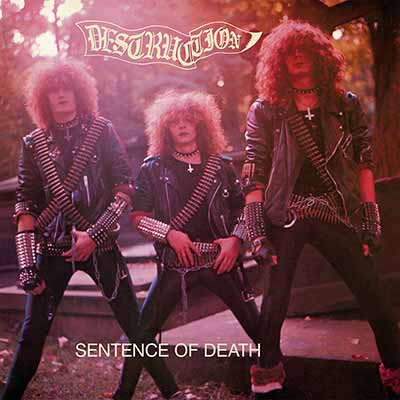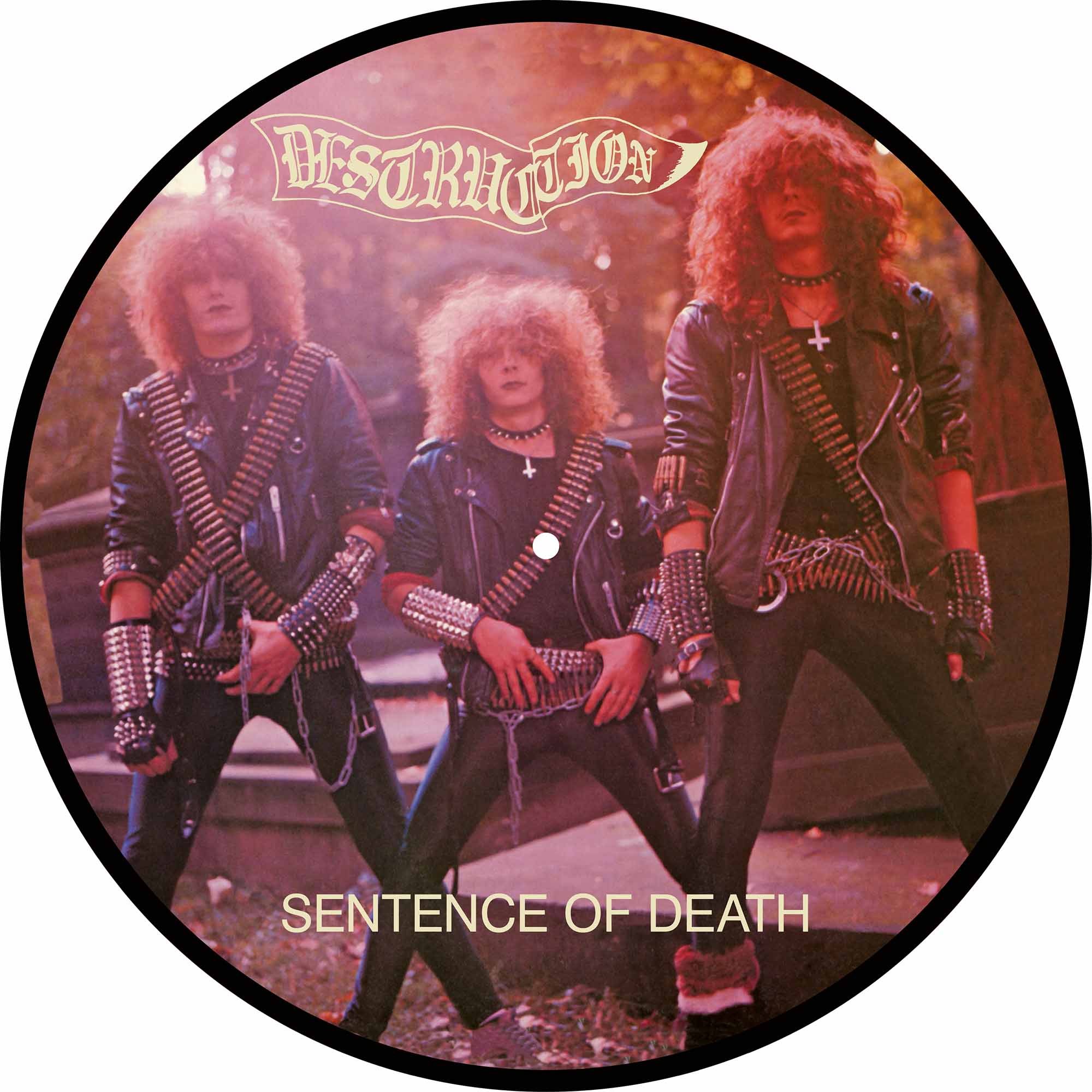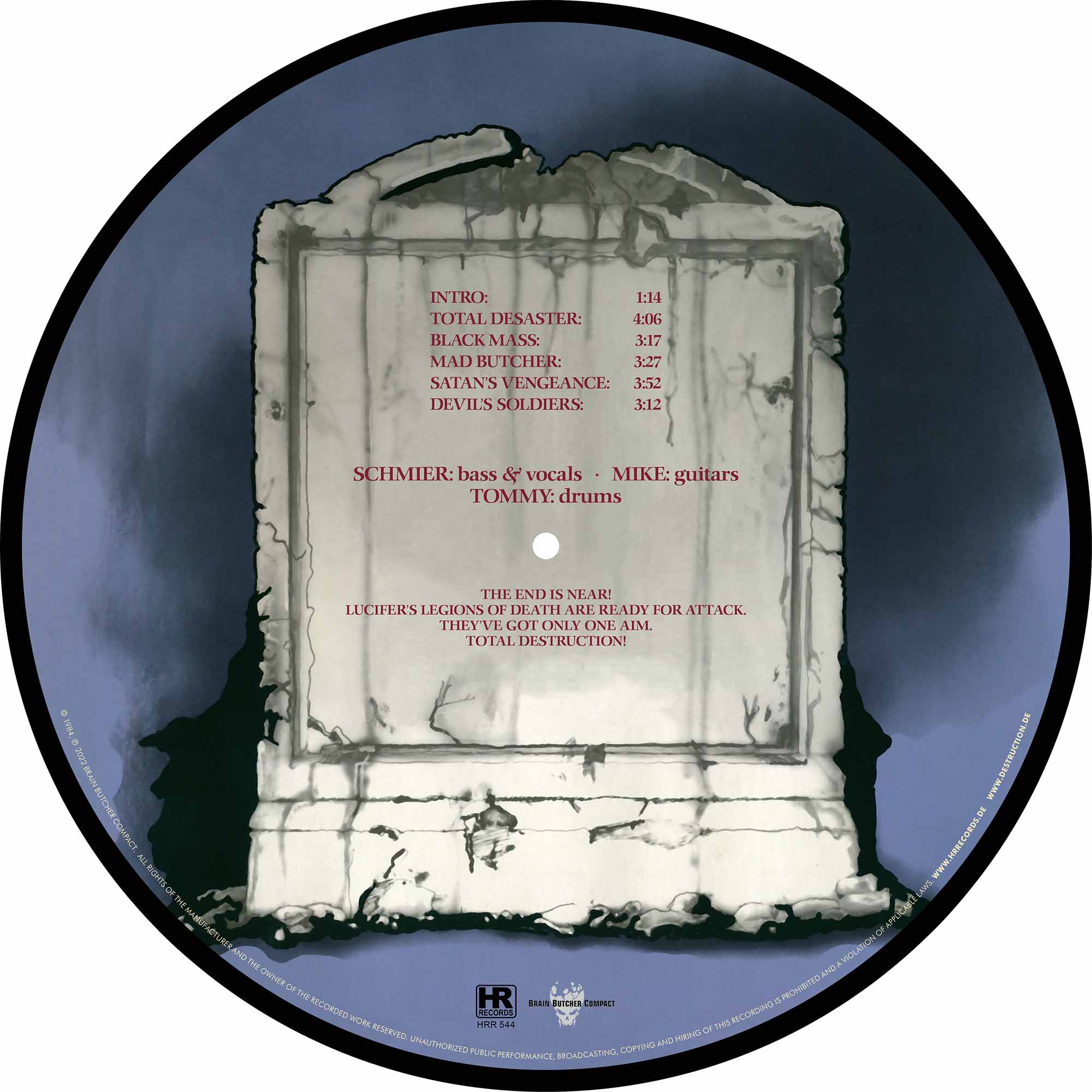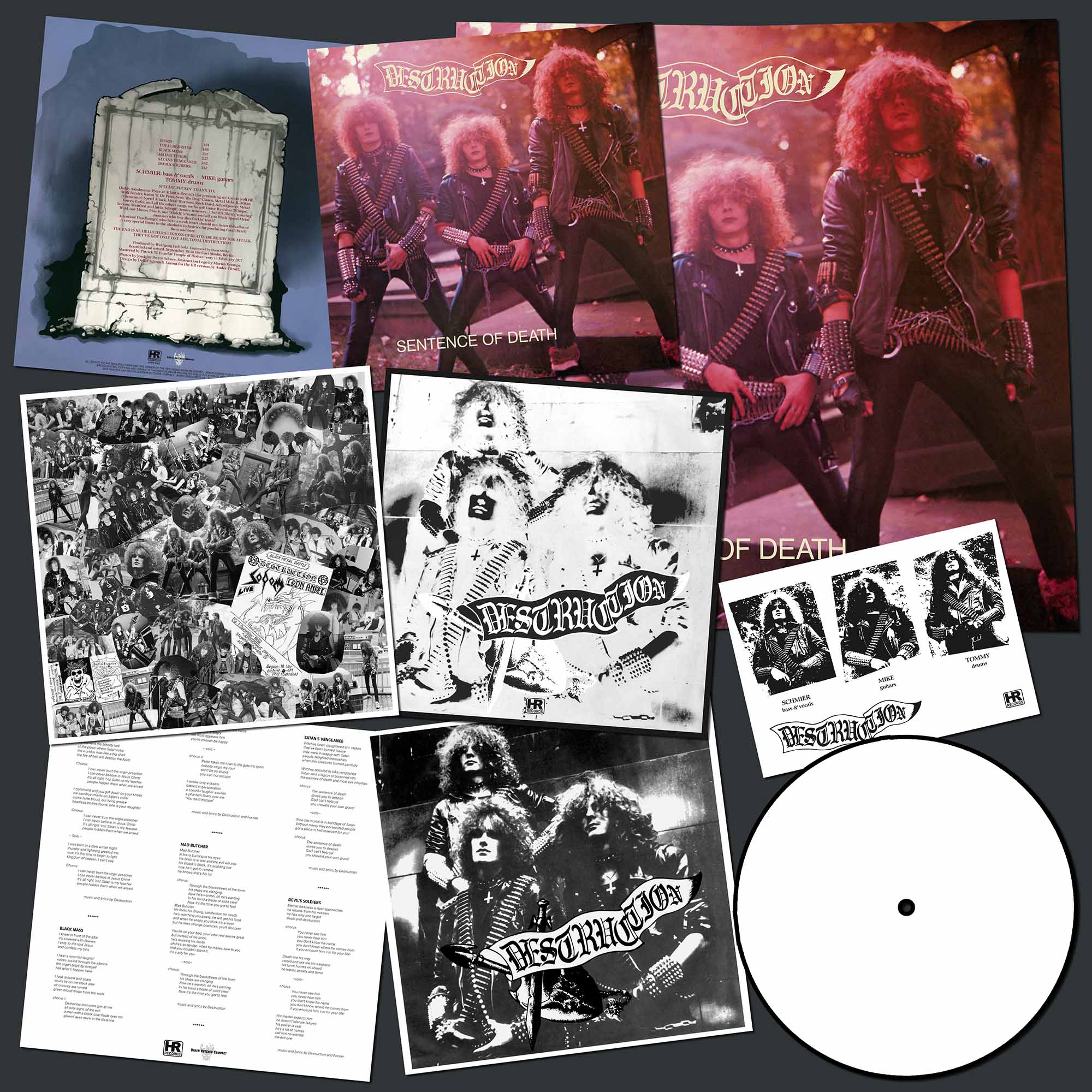 | ||||
| DESTRUCTION - Sentence of Death PICTURE MLP EURO COVER | |
HRR 544PLP, COMMEMORATIVE EDITION, 40 YEARS OF UNLIMITED THRASH, ltd 500, individually numbered, 425gsm heavy cardboard cover, printed inner sleeve, insert, A5 photo card, poster | |
| Schmier - Bass, Vocals Mike Sifringer - Guitars Tommy Sandmann - Drums | |
| 1. Intro 2. Total Desaster 3. Black Mass 4. Mad Butcher 5. Satan's Vengeance 6. Devil's Soldiers | |
AVAILABLE | |
Mastered by Patrick W. Engel at TEMPLE OF DISHARMONY in February 2017. Original 1984 sound!
Sure as hell, Destruction need no introduction – but sure as hell, they deserve a proper one! And who knows, perhaps there are still some people out there who have not yet heard of the legendary thrash metal pioneers... to put an end to that, vocalist and bassist Schmier himself gives a very short history of how he and his two original bandmates Mike Sifringer (guitars) and Tommy Sandmann (drums) got together in 1982 to form Destruction: “We were the only headbangers in the Southwestern German region of Weil am Rhein/Lörrach in the early 80s – really just a handful of people. This band called Knight of Demon was looking for a bass player and because I had a denim vest with patches and long hair, they came to me at a party and asked me to join... I was thrilled but I had no idea how to play the bass at that time. The next day we went to buy me a bass guitar!” An epic start for an epic career, although at that time, the band's goals were not set too high: “Our only goal was to have fun with the music, to break out of the conservative environment and celebrate heavy metal together. Our main influences at that time were Jaguar, Angel Witch, Venom and Exciter.”
Knight of Demon soon changed their name to Destruction – what was the reason? “We wanted to be heavier, much heavier and faster, so the old name did not fit anymore. 'Sonic Destruction' sounded great to us, so we voted for Destruction. At the same time our second guitar player Ralf left and we lost our rehearsal room.”
Before “Sentence of Death” but still in the same year, namely 1984, Destruction released their demo “Bestial Invasion of Hell”. What kind of development had taken place in between the two, if there was time enough at all for any bigger development? This time Tommy gives the answer: “There was not much time in between the release of the demo tape and the recording of 'Sentence of Death'. So, from my point of view, time was too short to achieve any significant developments. Maybe one thing though – we tried to set up a new speed mark with the song 'Devil’s Soldiers'. This song had been written after the demo was recorded.”
“Sentence of Death” was fist released via Steamhammer. How did the deal with them come into being? “We were very proud of our demo, so we sent out the tapes to some labels. Noise Records replied stating that they do not sign punk bands... hahaha! But Steamhammer and some others got interested in our noisy sound. We decided SPV/Steamhammer was the biggest label at that time and, inexperienced as we were, we signed a kind of slavery deal that bound us for many years... hahaha!”
The EP was recorded and mixed in September 1984 at Caet Studio, Berlin. Is that correct? Who else was involved in recording, mixing and mastering the EP?
Schmier: “Yes that is correct, the label was setting this up for us. It was Horst Müller who did all the mixing and mastering and Wolfgang Eichholz – who was the guitar player of the band S.A.D.O. – produced the EP. Müller did great so we kept him for 'Infernal Overkill'. He did all the work, while the producer was actually never there... Haha!” Schmier also shares his favourite anecdotes from the recording sessions: “Mike, the main songwriter, forgot his underwear, so he played all guitar parts in just one pair that he constantly wore, it makes for a crunchier sound right? Haha... I remember the face of the studio crew once we started to play! They were fuckin’ shocked!! I am sure they had never heard something that extreme until then...” What was it like to record in Berlin, a city that was still divided by a seemingly indestructible wall? Tommy remembers how impressed he was by the experience: “Well, we were village kids. None of us had been in Berlin before. So that was very exciting. We drove up to Berlin with a truck. Therefore it was mandatory to cross the border of the so called “German Democratic Republic”. The border guards found us very suspicious, and we were very sceptical concerning them as well. But after a thorough check we could finally pass. On the transit route to Berlin through the GDR we stopped at a motorway restaurant and had the worst so called cola drink I remember. The Berlin Wall was depressing. We did not try to cross the border, which in general was possible, but I don’t think the border guards would have let us cross. No wonder, really, because at that time we rather looked like guerrilla soldiers. After all we just wanted to be provocative. The legendary club 'Sounds' still existed back then, it was famous for delivering the backdrop of the famous movie “Wir Kinder vom Bahnhof Zoo” featuring David Bowie. We hung out there several times. It was a really cool place but not exactly a place for metal heads. In Berlin such a scene did not yet exist, or at least we didn’t know about it.” Schmier also has something to add: “Yes, it was a great experience for us. We experienced the real world this way. We were thrilled and excited. And driving through the corridor to West Berlin really was a historic moment, I remember I had chills. Berlin was a game changer for us for sure.”
“Sentence of Death” clocks in with a running time of 19:33. Why did Steamhammer decide to make the debut an EP and not a full-length album from the get-go? Schmier has the answer: “Our label took it as a test. They said if this works and the fans like it, we will sign you. I guess they weren’t sure ‘cause for the time we were super extreme. The rest is history, 'Sentence of Death' was a huge success and we got our big record deal!”
There were two songs from the demo that didn’t make it onto the EP, namely “Antichrist” and “Tormentor”. Instead there were two new songs on it, “Black Mass” and “Devil’s Soldiers.” What was the reason to leave out the two? “Because we sold a lot of demos in the underground, we wanted to offer the fans some new songs.”
What stories can the band tell about the now-iconic cover images of the demo and the EP, and about the photo shoots it took to get there? “We had the original first edition demo cover painted by my best buddy Schopfi. Later on, our manager Frank Stöver did a new front cover for the second edition of the demo tape. So the first version is a super-rarity. The second one is more common! The first photo session for the demo took place in my little village in between a cemetery and an old Nazi bunker. The label signed us cause they thought we looked like three brothers. The final photo session for 'Sentence of Death' took place on a cemetery in Hanover, SPV’s home-base.” Why was it decided to have a different picture for the American release and whose grave is it you’re sitting on? “For a long time we didn’t even know about the alternative cover used in America,” says Tommy. “We were very surprised when we found out about it. I don’t have a clue who made that decision. Nobody ever asked us about it. And I still have no idea whose decision it was and why the decision was made. The shot was taken in 1984 at the same photo session we used for the European edition. I don’t remember whose grave it was. Was it a real grave even?” Well, maybe some secrets mustn't be revealed. But how did fans and press react to the EP? Schmier: “Reactions were overwhelming, we had never expected something like that. Fan reactions were fantastic – whereas not everyone from the press liked the extreme style, so we did not only get great reviews...” With such a chiefly positive feedback to the first official release, what changed for Destruction after “Sentence of Death” was out? “First of all, we only got the record deal because 'Sentence of Death' was a success. So we quickly started writing material to record the first LP 'Infernal Overkill'. Apart from that, there wasn't much that changed for us, we still had no money but a lot of faith now... Haha!”
Looking back at the history of Destruction, what role did this debut EP play for the development of the band? Tommy answers this one: “It was the raw and aggressive first vinyl strike of a band that was hungry to be the hardest and fastest metal band. Many people say it set a standard. It was the ideal starting point for our first album.”
Is it possible to try to pinpoint which of the songs on “Sentence of Death” have become the most important for the band, and for what reason? Of course it is: “'Mad Butcher' became the trademark song of the band because of the crazy catchy riff and, of course, because of the splatter lyrics. 'Total Desaster' is still one of my faves because of the punk attitude and the pure energy of the songwriting. Great fun to play live, even after 34 years!”
Back then, what was your relationship to the other bands that today are known as “the big four of German Thrash” like? And would the three young guns ever have imagined to become as influential as they did? Schmier: “We were so happy that we had found other bands in Germany that were making the same kind of extreme music. So we became friends really quickly. We were outlaws of the music industry at that time. Nobody ever thought that this extreme style of heavy metal would go anywhere. None of us ever thought that we could be influential, we did not care, we just wanted to play music and have a good time.”
Destruction are also counted as one of the most influential bands in the development of Black Metal. Was it a conscious choice to lean into that direction or did it just happen? “At that time evil horror lyrics were the most extreme we could write to provoke, so we did it, we were 17 years old and wanted to piss off the mainstream and we did it!” explains Schmier. He also gives an account of how he remembers the year 1984, which is usually counted as one of the milestone years for thrash metal and metal as such. What were the most important releases that year, from his point of view? “I think 1984 was a great start for many bands but the scene became even stronger and bigger in 1986/1987. The word thrash metal wasn’t even born at that time but 'Ride the Lightning' and 'Fistful of Metal' plus Metal Church’s first self-titled release were the most impressive albums of that year in my book!”
And what else should anyone keep in mind who goes in for this piece of thrash metal history? Schmier gives the last answer for today and adds some words of wisdom: “Nobody took us serious at that time. We were three young and wild kids from the conservative German Southwest that wanted to break out of their old, boring bourgeois-lifestyle! It shows that underdogs can break thru if you believe in yourself and in what you do...”
Ulrike Schmitz



